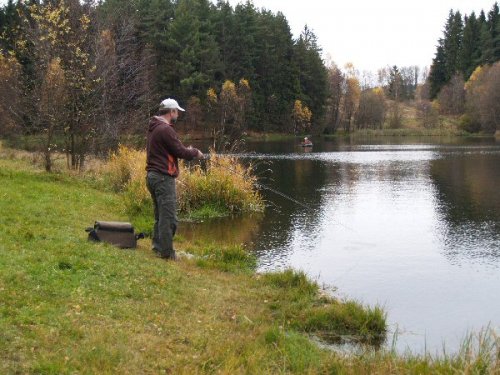Basic tactics for trout in small waters.
The growth of small fisheries throughout the UK, and Scotland in particular, has led to the development of new methods of trout angling. Most of these fisheries are 'fly-only', although a number also include facilities for bait anglers. This, however, is a relatively recent occurence, because it was once believed that fishing with bait was somehow a lesser pursuit than fly-fishing - but gladly, these days are fading. If you wish to fish with bait, and it is within the regulations, do so. If you wish to fish with fly, do so. Do not criticise one or the other. The world is large enough for everyone to enjoy their own pastime as long as it does not impinge on the enjoyment of others. To define what constitutes a small stillwater fishery is difficult because everyone's idea of what is 'small' will be different. Perhaps a better description would be 'purpose-built' as the great majority of small trout fisheries are natural waters, which have been modified. It is the methods and tactics which are of greatest interest here, and these have moved away dramatically from the traditional styles of fly-fishing in Scotland.
New tactics have evolved because, in small waters, trout behave differently. Trout in larger lochs, particularly brown trout, tend to hold station at a chosen depth contour. Often this is just deep enough for them to feel safe, while still enjoying the benefits of abundant shoreside (shallow) feeding. In other words, they congregate in predictable areas of lochs. This may change due to wind speed, direction, time of year, temperature and all the other factors that influence fish behaviour, but as a general rule the 'certain depth' concept holds. This, however, is not the case in small stillwaters - or at least, not to the same extent. The reasons for this are fairly logical. Almost invariably, small stillwaters contain rainbow trout. These waters are frequently stocked; a system of 'put-and-take' is usually implemented meaning that each fish caught is replaced, thus maintaining a designated level of stock. Several issues arise from this. The first is that stock fish often swim in shoals as they did in their breeding ponds. This is similar behaviour to big cats in zoo cages - they tend to pace around constantly following a predictable route round their enclosure.
The second issue is that they feed in a conditioned way. When one fish swirls at a food item, the others recognise the activity and act similarly. Feeding in their rearing cage may have been done by hand with pelleted food thrown into the water at particular times of the day. As a consequence the fish have learned to expect food - a memory that persists long after their release into the fishery. Alternatively, they may have been fed from hoppers which were controlled by timers, but the net result is the same - when one fish chases food it stimulates the others to do the same. To a great extent, behavioural traits such as shoal swimming and feeding patterns influence small stillwater fishing. Because the fish are swimming in compact groups, it is highly likely that there is an opportunity to catch more than one fish. In this situation it would be advisable, after you have hooked your first fish, to go back to the same place, with the same fly as soon as possible. Don't stop to admire the first fish; there are plenty of others to catch! See if you can predict the sequence of fish as they pass by. The route that they take will be very much the same each time. By observing carefully, you may be able to foretell when the shoal comes into your casting area or get into a position to exploit the shoaling activity. This shows a distinct movement away from the 'prospecting' type of fishing, which was traditionally the norm in Scotland.
As newly-stocked fish gradually break away from their shoaling habit, they become more interested in natural feeding practices. They do not expect regular pellet meals - the realisation that they must fend for themselves presumably dawns on them. They then start to look for things to eat. They mostly feed on midge species, for anything larger will have been rooted out and consumed long ago. Small stillwaters tend to have a limited range of aquatic organisms. There are large numbers, but few species. There are often a few species of upwing ephemerid flies, a population of water boatmen beetles, plus the ubiquitous chironomid midges 'buzzers'. The use of midge imitation has transformed much of stillwater fishing and this has transferred from the small stillwaters to larger lochs. Buzzer fishing encompasses the use of flies tied to imitate the three distinct stages of the chironomid's life: bloodworm, midge pupa and adult midge. The pupal stage tends to be the most popular. Bloodworms are the larval stage of chironomid midges, which as their name suggests, describes their legless, red, worm-like form. These tiny creatures are small, measuring from 1-2 mm, to a maximum of 7 -8 mm. They live in the mud on the bottom, feeding on vegetation and other organic detritus. Trout sometimes 'fossick about', stirring up the mud to disturb bloodworms, but it is the next stage of the midge's lifecycle that offers the greatest food potential and artificial fly pattern imitation. The larval bloodworm is the longest living stage of a midge's life (some for a whole year, most for many months). The next stage, the pupa, normally only exists for 36 to 72 hours. The pupa is the intermediate stage between the bottom-dwelling larva and the sexually-mature flying adult. The size, shape and colour of pupae vary with species, but resemble each other broadly. The head and wing cases are visible, although they are sheathed inside the outer casing. The body is segmented and slightly curved; there are light-coloured tracheal gills at the head, and light -coloured appendages at the tail end of the body, which aid propulsion. Imitative pupae flies have developed over the years. Most fly-tiers simulate the curved shape by tying the body well around the hook shank or even using curved-shanked hooks, and use a ribbing effect to suggest body segmentation. The majority of tiers find some way of imitating the thicker thoracic area and the tracheal gills. Although it is evident that there has been a clear advancement in fly design, the way in which they are fished is key to the greatest change in trout fishing.
The most obvious changes are the use of unconventional materials and the tactic of fishing the fly without movement. Anglers hang the flies in the surface film, simulating the behaviour of hatching pupae. At this point, movement of the artificial fly would be distinctly counterproductive. Anglers also use surface indicators that reveal when a fish has accepted the fly some way below the surface and employ various kinds of sighting cues like highly visible tufts of coloured wool, little plastic floats or dry flies. Tile fact that anglers use such accessories is suggestive of a need to watch the wily rainbows that take the bait. Conventional nylon monofilament needs to be very fine if it is to avoid detection by finicky rainbows, especially when they have so much time to inspect the static fly, so the use of fluorocarbon has become widespread. The fly patterns themselves have evolved in several ways. Firstly there are emerger patterns, which imitate the pupa hatching out into an adult fly at the point of breaking through the surface film. Pupae swim to the surface, hang with their gills poking up into the surface film, then turn upwards into a horizontal position before their sheath breaks open and the adult clambers out onto the water's surface. Emergers are semi-dry flies. They are hugely effective when trout are at, or near, the surface mopping up hatching midges. Artificial patters use plastic foam beads or the CDC feathers from the preen gland of ducks - 'cul-de-canard' - to keep them suspended in the surface film. Midge pupae are imitated as widely as any other type of artificial fly. Recently, the patterns have become simplified representations, rather than fussy imitations, using modern materials to simulate the natural size, colour and form. A coating of epoxy resin provides a shiny, sheath-like finish, which aids the fly's passage through the surface film to the correct depth. The use of small metal beads has become popular with 'goldhead' patterns and are very effective. Buzzer fishing has transformed small stillwater angling. It works best with rainbow trout, although it is a reasonably successful bait when fishing for brown trout. The slow, or better still, static presentation of the fly has moved away from rapid retrieval of lures and small wet flies, and adds a new and fascinating dimension to our sport.














